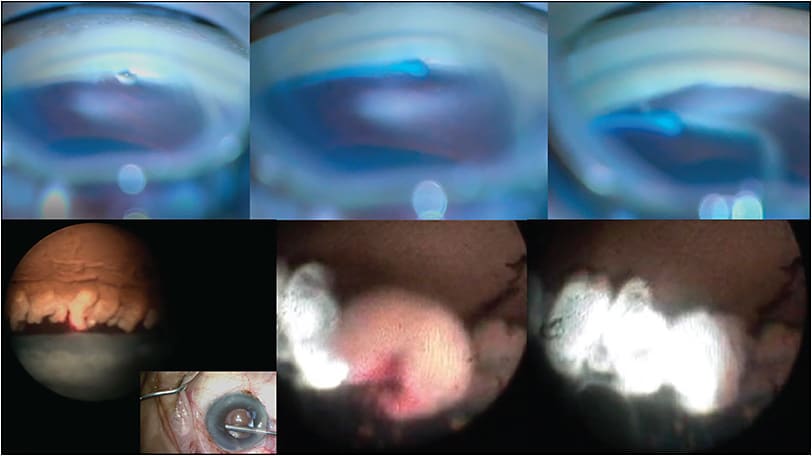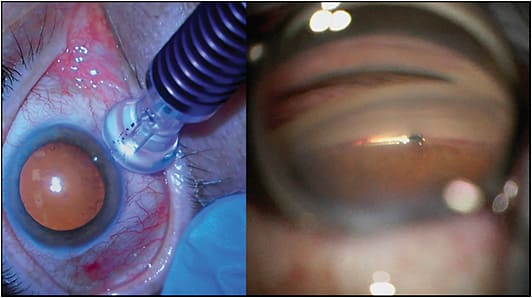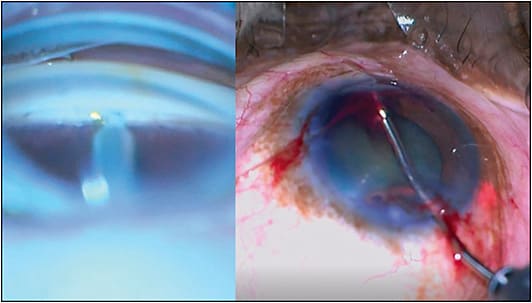Traditional glaucoma filtration surgeries, such as trabeculectomy and glaucoma drainage implants (GDI), have well-established efficacy in lowering intraocular pressure (IOP), but it comes at the cost of a very high rate of complications.1 Minimally invasive (or microinvasive) glaucoma surgeries (MIGS), in contrast, dramatically reduce the risk for complications but have been shown to be inferior in IOP reduction.2-4 Safety is always paramount, but many studies (AGIS, EMGTS) show that lower IOP is highly desirable because it decreases the risk of glaucomatous progression.5,6 The motivation for combining MIGS with different mechanisms of action is to try to achieve lower IOP than individual MIGS could accomplish alone, down to a level comparable to trabeculectomy and GDI, while keeping the safety inherent to MIGS.
Published data are sparse showing that combining multiple MIGS techniques can produce better IOP-lowering results than a single MIGS procedure alone. Ferguson et al published a retrospective comparison that is suggestive of the benefits of combining MIGS. They compared combined trabecular microbypass stent (iStent; Glaukos), cataract extraction, and endocyclophotocoagulation (ECP; BVI) with iStent and cataract extraction without ECP. At 12 months postoperatively, the group that received both iStent and ECP (n=51) had greater mean IOP reduction (7.14 mmHg vs 4.48 mmHg) than the group that only received iStent (n=50).7
The MIGS Study Group published a prospective study on a combination of 2 iStents, and 1 suprachoroidal stent (iStent Supra; Glaukos) with a postoperative prostaglandin (travoprost) in 80 phakic open-angle glaucoma patients who had failed a prior trabeculectomy. Preoperatively, the mean IOP was 22.0±3.1 mmHg on 1.2±0.4 medications. Through 4 years of follow-up, the average postoperative IOP ranged from as low as 12.2 mmHg to no higher than 13.7 mmHg at all time points. Ninety-seven percent of eyes achieved an IOP of 15 mmHg or less. There were no severe complications and no eyes required additional glaucoma surgery.8
Personal Unpublished Outcomes of Combined MIGS Procedures
I first started performing combinations of MIGS procedures in 2013, and I presented the data at the American Glaucoma Society meeting in San Francisco, California, in March 2019.9 The types of outflow MIGS utilized in my patients were 2 iStents, iStent Inject, Trabectome (Neomedix), Kahook Dual Blade (KDB; New World Medical), Hydrus (Ivantis), Trab 360, Visco 360, Omni (Sight Sciences), Cypass (Alcon), gonioscopy-assisted transluminal trabeculotomy, and ab interno canaloplasty using a lighted microcatheter (Ellex iTrack). The cyclophotocoagulation (CPC) techniques utilized were Micropulse transscleral CPC (Iridex) and ECP.
So far, I have accumulated 80 combined MIGS cases. The average age of patients was 69, 65% of patients were black, and 29% were white. As a group, the patients had severe visual field loss with an average mean deviation of -15.2 dB, and 27 patients had failed prior glaucoma surgeries. Surgery was combined with phacoemulsification cataract surgery in 49 patients. The average pretreatment IOP was 33±9.0 mmHg and the average preoperative IOP was 22.2±7.0 mmHg on 3.3±1.2 medications. The average postoperative IOP at last follow-up (ranging from postoperative month 1 to year 5) was 13.3±3.2 mmHg on 2.6±1.0 medications. Throughout the 5 years of follow-up, the average IOP ranged from as low as 11.2 mmHg to no higher than 13.6 mmHg at all time points.
There were 13 failures (16%) who went on to require additional glaucoma surgery. Seven were managed with GDI, 2 with Xen 45 implants (Allergan), 1 with Cypass, 1 with micropulse transscleral CPC, and 1 with cataract surgery combined with synechialysis and ECP. One patient refused any additional surgical intervention. Those who failed had a significantly higher average preoperative IOP (26.8±8.8 mmHg) than the overall group (22.2±7.0 mmHg). Of note, there were 4 patients who received selective laser trabeculoplasty at some point during their postoperative course but did not go on to require additional glaucoma surgical intervention.
Nineteen patients (24%) had complications, which included 6 cases of rebound iritis, 6 stent occlusions, 5 IOP elevations >40 mmHg, 3 cases of cystoid macular edema, 2 fibrinous anterior chamber reactions, 2 retinal detachments, and 1 hypotony maculopathy.
One specific subgroup that is of particular interest is the group of 27 eyes that had failed prior glaucoma surgeries: trabeculectomy and/or GDI. Their average preoperative IOP was 21.5±7.1 mmHg on 3.7±1.0 medications. Average postoperative IOP at the last follow-up (from postoperative month 1 to year 5) was 12.6±2.7 mmHg on 3.1±1.0 medications. There were 6 failures (22%) in this group. Combined MIGS may be a reasonable surgical alternative in patients who have proved refractory to prior trabeculectomy and/or GDI.
Isolating Different Combinations of MIGS
There are many different potential combinations of MIGS procedures. Following is the breakdown for my series of 80 cases.
Thirty-nine of these eyes received some manner of trabecular meshwork bypass technique combined with some form of CPC. Trabecular meshwork bypass techniques used included 2 iStents, iStent inject, Hydrus, Trabectome, KDB, gonioscopy-assisted transluminal trabeculotomy, ab-interno canaloplasty, Visco 360, Trab 360, and Omni. Cyclophotocoagulation techniques used included ECP and micropulse (Figures 1 and 2). Their average preoperative IOP was 21.7±6.9 mmHg on 3.4±1.3 medications and the average postoperative IOP at last follow-up (from postoperative month 1 to year 5) was 12.6±3.2 mmHg on 2.4±1.2 medications. There were 5 failures (13%).


Thirty-two eyes received a combination of supraciliary stent (Cypass) with trabecular meshwork bypass (2 iStents, KDB, or Trab 360; Figures 3 and 4). The average preoperative IOP was 23.8±8.6 mmHg on 3.6±1.0 medications and the average postoperative IOP at last follow-up (from postoperative month 1 to year 2) was 14.1±3.9 mmHg on 2.8±1.1 medications. There were 7 failures (22%).


Nine eyes received ab-interno canaloplasty (with either lighted microcatheter or Visco 360) combined with trabecular meshwork bypass (KDB, Trabectome, 2 iStents, and iStent inject) (Figure 5). Their preoperative IOP was 18.7±3.7 mmHg on 2.1±1.7 medications and their average postoperative IOP at last follow-up (from postoperative month 1 to year 4) was 14.6±3.1 mmHg on 2.3±0.9 medications. There was 1 failure (11%).

Significance and Potential Applications
In general, MIGS procedures, with their modest efficacy, have been thought of as only being applicable for those with mild to moderate disease with target IOP in the mid to high teens. Those with severe disease who require lower IOP have generally been relegated to trabeculectomy and GDI. However, my experience with combined MIGS shows that the average postoperative IOP and standard deviation are actually quite low across all combinations and across all time points, and they are very comparable to published results of trabeculectomy and GDI.10 This suggests that combined MIGS procedures may be able to serve as a viable alternative in patients with severe disease and advanced field loss who require a target IOP in the low teens. Combined MIGS can also be effective in those who have already failed trabeculectomy and GDI whose surgical options might otherwise be dwindling.
Considerations and Hurdles
Although the overall IOP lowering was satisfactory in my combined MIGS cases, the postoperative medication burden remained quite high, in the 2 to 3 range. Combined MIGS gave, on average, a modest reduction of 1 medication from preoperative levels. Very few patients were able to stop all of their medications. This may have been due to the advanced nature of the disease afflicting most of the patients in the study and the perceived need for very low IOP. If the disease were milder and the goal IOP more modest, the postoperative medication burden could have been lower.
Combining MIGS may not be ideal or necessary for every patient. The potential benefit has to outweigh the potential added risk. Without a doubt, trabecular bypass MIGS are very safe with very little risk aside from transient hyphema. However, micropulse and ECP, although also very safe, do run the small added risk of inflammatory complications. Suprachoroidal devices, like Cypass, have the unwelcome disadvantage of occasionally causing transient cyclodialysis clefts and hypotony. None of these complications were persistent or insurmountable, but they were unwelcome nonetheless. Also, a few patients had very high acute IOP elevations postoperatively, which could be problematic for patients with pre-existing advanced field loss with very little reserve.
The effect on reimbursement of combining MIGS is a major consideration for some surgeons. An alternative is staging MIGS by performing 1 modality first and then performing a second later if necessary, with the disadvantage being the need for another trip to the operating room and incision into the eye.
Combining MIGS procedures to achieve lower IOP comparable to trabeculectomy and GDI while keeping the coveted safety profile of MIGS is an exciting new frontier in glaucoma surgery. It represents an important alternative in our surgical armamentarium that warrants greater consideration and study. GP
References
- Gedde SJ, Herndon LW, Brandt JD, Budenz DL, Feuer WJ, Schiffman JC; Tube Versus Trabeculectomy Study Group. Postoperative complications in the Tube Versus Trabeculectomy (TVT) study during five years of follow-up. Am J Ophthalmol. 2012;153(5):804-814.
- Richter GM, Coleman AL. Minimally invasive glaucoma surgery: current status and future prospects. Clin Ophthalmol. 2016;10:189-206.
- Chen DZ, Sng CCA. Safety and efficacy of microinvasive glaucoma surgery. J Ophthalmol. 2017;2017.
- Agrawal P, Bradshaw SE. Systematic literature review of clinical and economic outcomes of micro-invasive glaucoma surgery (MIGS) in primary open-angle glaucoma. Ophthalmol Ther. 2018;7(1):49-73.
- The Advanced Glaucoma Intervention Study (AGIS): 7. The relationship between control of intraocular pressure and visual field deterioration. The AGIS Investigators. Am J Ophthalmol. 2000;130(4):429-440.
- Heijl A, Leske MC, Bengtsson B, Hyman L, Bengtsson B, Hussein M; Early Manifest Glaucoma Trial Group. Reduction of intraocular pressure and glaucoma progression; results from the Early Manifest Glaucoma Trial. Arch Ophthalmol. 2002;120(10):1268-1279.
- Ferguson TJ, Swan R, Sudhagoni R, Berdahl JP. Microbypass stent implantation with cataract extraction and endocyclophotocoagulation versus microbypass stent with cataract extraction for glaucoma. J Cataract Refract Surg. 2017;43(3):377-382.
- Myers JS, Masood I, Hornbeak DM, et al. Prospective evaluation of two iStent trabecular stents, one iStent Supra suprachoroidal stent, and postoperative prostaglandin in refractory glaucoma: 4-year outcomes. Adv Ther. 2018;35(3):395-407.
- Oguntoye M, Chen K, Mudaliar S, Kim WI. Combining MIGS for the treatment of open angle glaucoma: a long term retrospective study. Poster presented at: AGS Annual Meeting; March 14, 2019; San Francisco, CA.
- Gedde SJ, Schiffman JC, Feuer WJ, Herndon LW, Brandt JD, Budenz DL; Tube versus Trabeculectomy Study Group. Treatment outcomes in the Tube Versus Trabeculectomy (TVT) study after five years of follow-up. Am J Ophthalmol. 2012;153(5):789-803.









